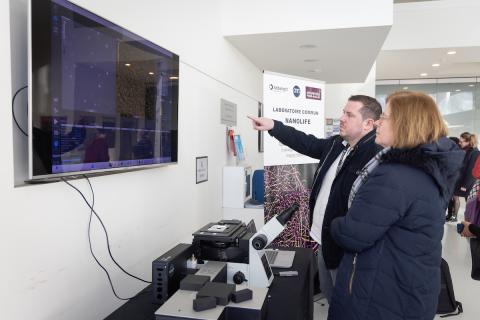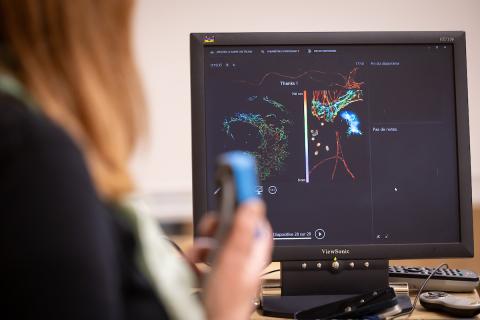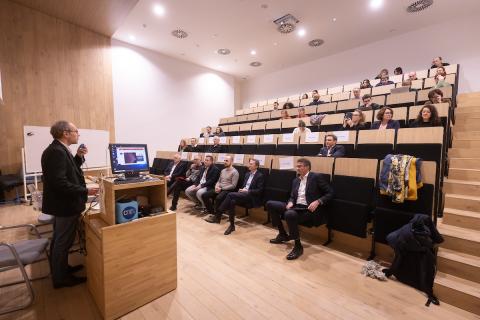Abbelight, CNRS and Université Paris-Saclay join forces to advance imaging of living organisms
On Friday 2 February 2024, the company Abbelight, specialised in the development of microscopy and nanoscopy solutions, the French National Centre for Scientific Research (CNRS), and Université Paris-Saclay officially signed the creation of a joint research laboratory specialised in nano-scale imaging.
The scale-up company, Abbelight, the CNRS and Université Paris-Saclay have recently strengthened their partnership with the launch of a joint laboratory – Nanolife. Bringing together Abbelight and the Orsay Institute of Molecular Science (ISMO), the joint laboratory aims to solve the main technological and scientific challenges in fluorescence nanoscopy of living cells, via a major scientific project.
Nanolife’s objective draws on ISMO and Abbelight’s capacities to develop imaging of living organisms, which remains limited today.
ISMO has patented and considerable expertise in conventional and super-resolution fluorescence microscopy, as well as sample preparation and related data processing.
In addition to ISMO’s scientific expertise, Abbelight’s super-resolution imaging technique - Single Molecule Localisation Microscopy (SMLM), will play a key role in improving the temporal resolution needed for the observation of living organisms.
SMLM is an optical imaging solution that provides 3D nanometric spatial resolution, which is similar to that of electron microscopy. While the inventors of SMLM were awarded the Nobel Prize in Chemistry in 2014, the solution currently remains limited to the imaging of fixed biological samples and presents several drawbacks. These include: acquisition times ranging from a few minutes to several hours, which is far from the temporal resolution needed for the observation of living organisms; particularly phototoxic light excitation samples, especially during long acquisition times; and SMLM probes attached to immunolabeling antibodies which cannot penetrate living cells.
The purpose of the Nanolife joint laboratory is to tackle these challenges. The project “will help to improve our knowledge about the photo-blinking process of SMLM probes, as well as the development of a new SMLM instrument covering the entire value chain, from sample preparation to image analysis,” said Nicolas Bourg, CTO and co-founder of Abbelight. Nanolife will also give SMLM nanoscopy the chance to become the microscopy of the future and consolidate Abbelight’s position as a leader on the SMLM nanoscopy market. The new laboratory will also allow ISMO to reinforce its excellence, reputation and expertise in this particular field, whilst continuing to develop new knowledge.
The development of SMLM imaging techniques will contribute to research in life sciences, and a vast array of areas, including cancer, genetics, biophysics, microbiology and neuroscience.
“The CNRS is very pleased that our relationship with Abbelight has continued to grow over time, as the company first emerged from laboratories jointly run by the CNRS. The creation of Nanolife is a reminder of why the economic world and public research must maintain close links. In fluorescence nanoscopy – an area which we both have in common, the Orsay Institute of Molecular Science possesses expertise and knowledge which meet a key industry need. It is also a powerful symbol because the partnership demonstrates that public-private research collaborations are both desirable and possible with all types of companies, from start-ups to large corporate groups,” said Jean-Luc Moullet, Deputy Managing Director for Innovation at the CNRS.
“It is incredibly satisfying to see public-private partnerships like this, related to work from our research laboratories, becoming a reality. Advancing the frontiers of basic knowledge whilst promoting the role this knowledge has to play in innovation and value creation for society is at the heart of university missions, and of Université Paris-Saclay’s in particular. We are delighted about the creation of Nanolife, which will combine top-level academic and technological expertise whilst contributing to the training of students and young researchers, to help overcome the technological obstacles in the imaging of living organisms,” said Estelle Iacona, President of Université Paris-Saclay.
The creation of a joint laboratory is the continuation of a shared past between Abbelight and ISMO. The company first emerged at ISMO from the research of one of its founders, Nicolas Bourg, during his thesis as part of the NanoBio team, supervised by Sandrine Lévêque-Fort, also co-founder, and Guillaume Dupuis, director of the Nanolife laboratory. During his thesis, Nicolas Bourg designed a 3D isotropic nanoscope to improve our understanding of neurodegenerative diseases and the cell migration of human macrophages.
An official signing ceremony marking the creation of the Nanolife joint laboratory took place on 2 February at ISMO. The event was attended by Jean-Luc Moullet, Deputy Managing Director for Innovation at the CNRS, Estelle Iacona, President of Université Paris-Saclay, Jean-Baptiste Marie, CEO of Abbelight and the teams involved in the project. The signing was followed by a demonstration of the Abbelight™ SAFe bioimaging platform.



